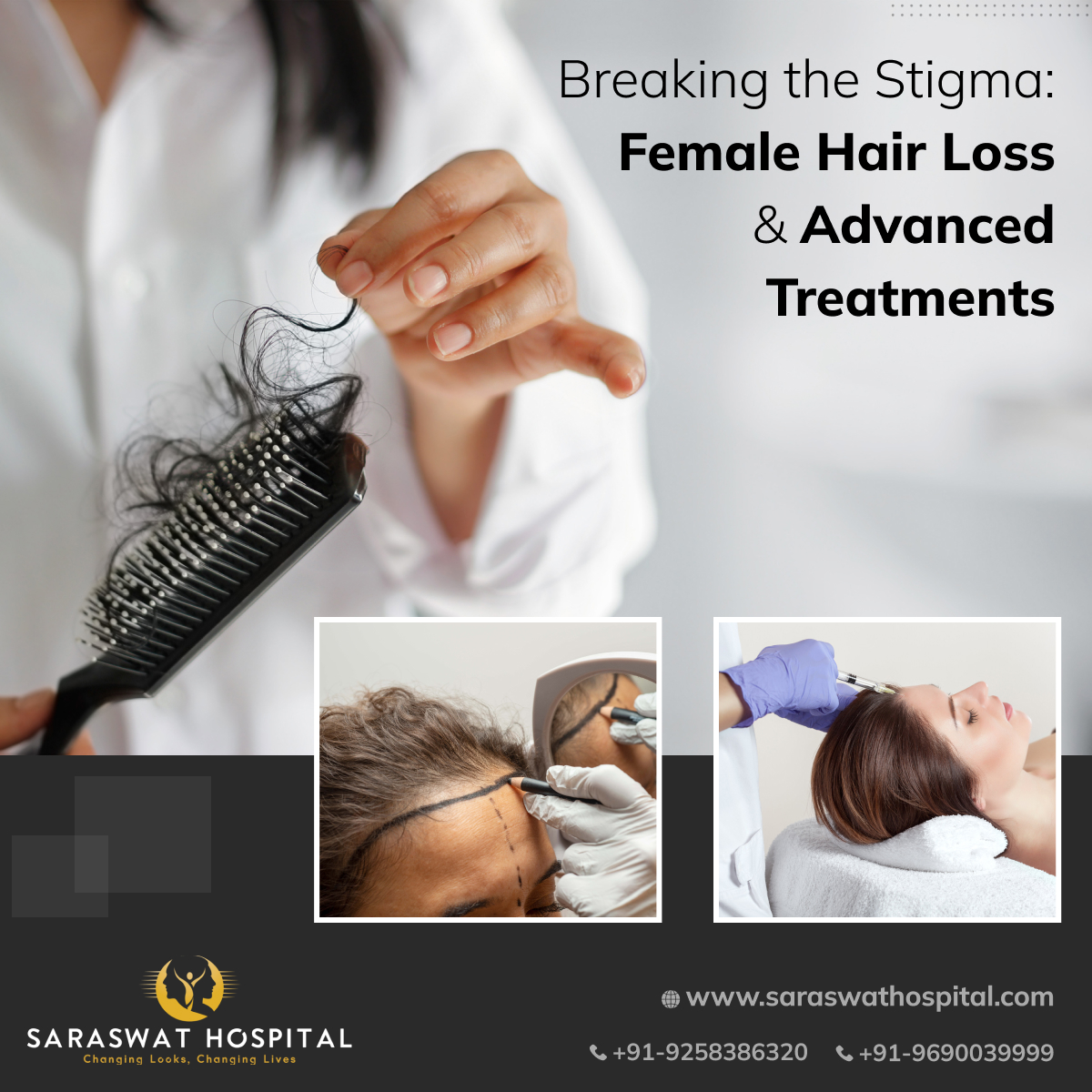Hair loss can be a distressing experience for anyone, especially women. While male pattern baldness is a well-known phenomenon, hair loss in women is less talked about but is no less common. In fact, about one-third of women experience hair loss at some point in their lives, and two-thirds suffer from hair thinning or bald spots. Hair loss or thinning can severely affect a woman’s well-being and quality of life. There can be various causes of hair loss, including genetics, hormonal changes, stress, medical conditions, etc. With the best hair loss treatment for females, hair regrowth is possible in some cases. In this blog, we will learn the direct causes of female hair loss and the different treatment options available in reputable hair restoration clinics like Saraswat Hospital.
Normal Hair Fall vs. Hair Loss
Losing 50 to 100 strands of hair in a day is normal. There is a balance between hair fall and new hair growth. However, it can turn out to be a concern if the balance is interrupted and one experiences more hair fall than new hair growth. Remember, hair loss is a gradual process that leads to thinning hair or bald spots.
If a woman finds her partings widening, has bald spots, or is shedding more than 100 strands of hair in a day, she must seek professional help as soon as possible.
Direct Causes of Hair Loss in Women
There are various reasons that can contribute to female hair loss. Some of them can be diagnosed by medical tests, while a few are diagnosed by exclusion. Reasons that are diagnosed have a better prognosis, though how much hair can be retrieved cannot be predicted in any case.
1. Nutritional Deficiencies
Nutritional deficiencies can be a common cause of female hair loss. When the body lacks certain essential nutrients, it can affect the growth and health of hair follicles. For example, deficiencies in vitamins D3, B12, and folate, as well as iron, protein, calcium, etc., can trigger hair loss in women. Vitamin B12 is important for healthy red blood cells. It carries oxygen to the scalp and hair follicles. On the other hand, vitamin D3 helps with the hair follicle cycle and growth, and calcium and protein are important building blocks for hair. Folate contributes to cell growth and division. Iron is essential for healthy blood flow and provides oxygen to the hair roots.
2. Hormonal Changes and Metabolic Disorders
A metabolic condition known as Polycystic Ovarian Syndrome (PCOS), which may or may not be seen with facial hair and acne, may trigger hair loss owing to its hormonal imbalance status. Apart from this, hormonal changes during pregnancy, childbirth, and menopause can contribute to hair loss in women. Problems with the thyroid gland can cause temporary or permanent female hair loss as well.
3. Alopecia Areata
Alopecia areata is an autoimmune disorder that causes hair loss in women. This disorder occurs when the immune system attacks the hair follicles, leading to hair loss in round patches on the scalp and sometimes other parts of the body. The exact reason behind this autoimmune disorder is still unknown, but it is believed to be related to genetic and environmental factors.
4. Scalp Infections
Scalp infections like ringworm or severe acne often cause hair loss in women. Ringworm is a fungal infection that affects the scalp and causes scaly patches. It can be itchy or painful. Due to a fungus attack, hair follicles become brittle and break off, resulting in hair loss. Sometimes, it can cause permanent hair loss if the hair follicles are badly damaged beyond repair.
5. Trichotillomania
It is a mental health condition that causes a person to have an irresistible urge to pull out their hair, often resulting in noticeable hair loss. Women are more likely to suffer from trichotillomania compared to men. Such a condition can make hair patchy, uneven, or thin.
6. Hair Styling and Chemicals
Hairstyles like very tight braiding or pulling often lead to traction alopecia. Similarly, chemical treatments such as those for permanent hair loss and smoothing can cause hair loss. Excessive use of heat during hair styling can also damage hair and cause more hair fall.
7. Stressful Events
Stressful events can cause hair loss. For example, an acute illness like viral fever, typhoid, pneumonia, COVID, surgery, childbirth, etc., may cause hair loss in women. However, with a little care for overall health, one can regain normal hair growth in such cases.
8. Fibrosing Alopecia
Scarring hair loss occurs when hair follicles are destroyed and replaced by scar tissues. It is a rare form of alopecia and affects women, often leading to permanent hair loss. Fibrosing alopecias like FFP, LP, and CCP may cause gradual hair loss accompanied by itching, tingling, burning, or tenderness on the scalp.
9. Trauma, Burn, or Radiation Therapy
Trauma, burns, or radiation therapy may cause sudden hair loss. In these cases, hair follicles can be damaged and fall out as a result. Radiation therapy used to treat conditions like cancer may cause temporary or permanent hair loss.
10. Female Pattern Hair Loss
Finally, the most common—about one-third of women experience female pattern hair loss, which is multifactorial genetic & may be hereditary too. It is the female counterpart of male pattern baldness. It may cause thinning of the hair in women with increased scalp visibility.
Advanced Female Hair Loss Treatments
Dealing with hair loss and low confidence levels is not a choice. If lifestyle modification, a balanced diet, and other OTC treatments like the use of minoxidil, low-laser therapy, etc., do not offer the desired hair growth, you should go for advanced female pattern hair loss treatments. Hair transplantation is an effective hair growth treatment for women. Apart from this, mesotherapy and platelet-rich plasma therapy are also effective female hair loss treatments. Some patients do not respond to any of these treatments. They can undergo scalp micropigmentation procedure to camouflage bald spots and thinning hair, giving the appearance of a head full of hair.
-
Hair Transplantation
Hair transplantation is a popular hair loss treatment for women. It is an advanced surgical procedure to transfer healthy hair follicles from one area (donor area) of the scalp to another area (recipient area) that is experiencing hair loss or thinning. The procedure can be performed using various techniques, including follicular unit transplantation (FUT) and follicular unit extraction (FUE).
In the FUE procedure, surgeons take individual hair follicles out of the skin and implant them elsewhere in the body. Surgeons follow procedures like micropunching to extract single follicles and move them without leaving any sign of extraction. FUT is a less invasive procedure and is effective at covering bald spots caused by hair loss. Here, the hair transplant surgeon cuts a strip of skin from the back or side of the head and then extracts individual hair follicles. After that, surgeons implant the extracted follicles into the balding parts of the skin. However, the results of hair transplants depend on the expertise of the surgeons and the advanced equipment used in the clinic.
Saraswat Hospital is an advanced hair restoration clinic that adheres to all international guidelines and protocols. Here, you can get treatment from expert hair transplant surgeons Dr. Satya Saraswat and Dr. Preeti Saraswat. Both of them are diplomats of the American Board of Hair Restoration Surgeons (ABHRS) and members of the Association of Hair Restoration Surgeons of India (AHRS).
-
Mesotherapy
Mesotherapy is another popular female pattern baldness treatment. This procedure concentrates on providing nourishment to hair roots. Doctors inject vitamin boosters and cocktails of serums into the mesoderm layer. It helps transform weak hair roots into healthy ones to boost healthy hair growth. Mesotherapy helps improve blood circulation of the scalp and boosts the growth of hair follicles.
-
Platelet-rich Plasma Therapy
Platelet-rich plasma therapy is one of the best hair loss treatments for females. It is a three-step procedure. First, a doctor collects the patient’s blood, processes it, and then injects it into the treatment area of the scalp. PRO can trigger hair growth by increasing the blood supply to the hair follicles and increasing the thickness of the hair shaft. Sometimes, doctors prefer to combine this hair growth treatment for women with other procedures or medications to ensure better results.
-
Scalp Micropigmentation
Scalp Micropigmentation, or SMP, does not boost hair growth or prevent hair fall. It is an effective way to get the appearance of a head full of hair. SMP is a cosmetic procedure that mimics the appearance of hair follicles. This is a quick and virtually painless procedure. One can get satisfactory results in one to three sessions, depending on the treatment area and scalp condition.
Conclusion
Without a doubt, female hair loss is an emotionally distressing condition. However, with the right treatment, one can address it and restore confidence. In order to get the best hair restoration solutions, you must consult experts like Dr. Satya Saraswat and Dr. Preeti Saraswat. They are American-board certified and have more than 19 years of experience. To consult them, you can contact the Saraswat Hospital in Agra. For appointment booking and further queries, you can send an email to saraswathospitalagra@gmail.com.








Leave a Reply